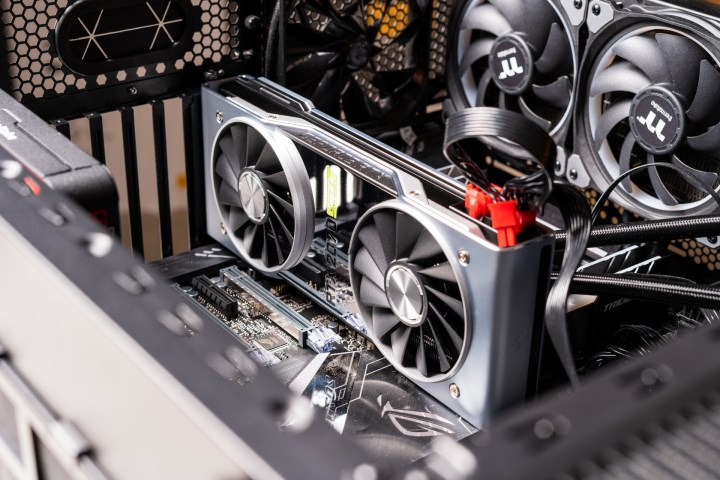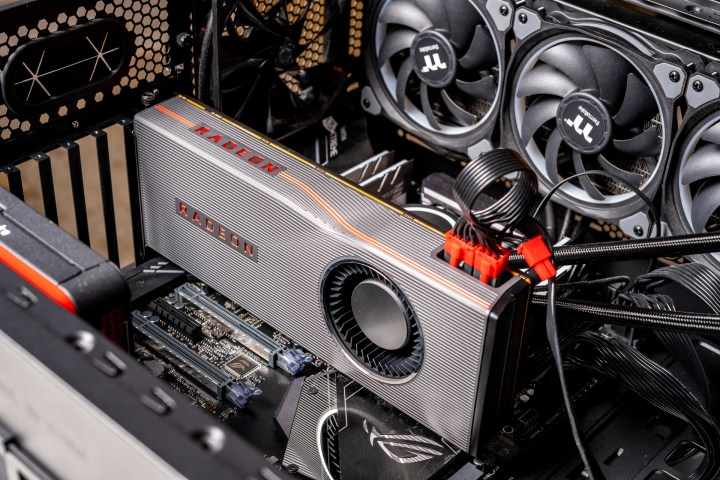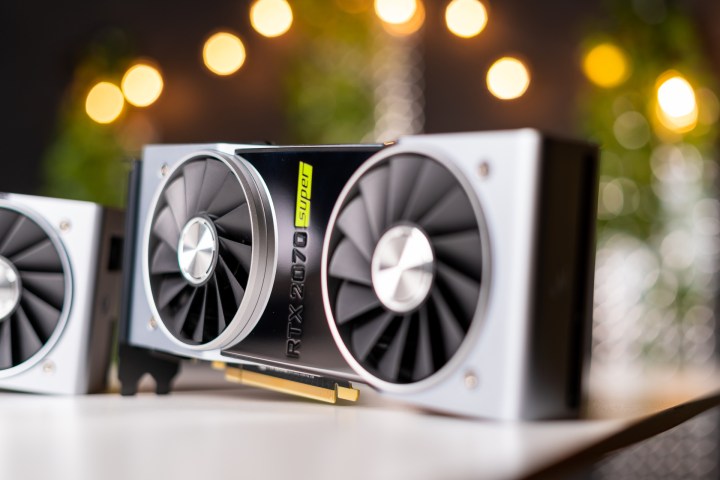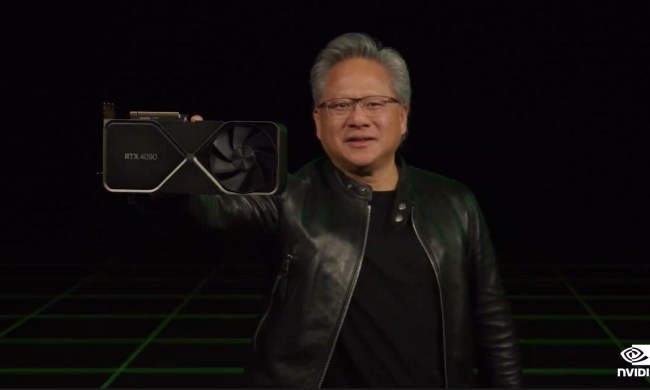The battle of last-gen GPUs comes down to two graphics cards: AMD’s Radeon RX 5700 XT and Nvidia’s RTX 2070 Super. Both cards deliver excellent performance at full HD and 1440p, and they’re not too expensive (if you can find one in stock). To help you decide between them, we threw both cards in the ring for this RX 5700 XT versus RTX 2070 Super comparison.
Before getting into it, keep in mind that there’s an ongoing GPU shortage. The 5700 XT and 2070 Super are both out of stock at all major retailers, and prices on the secondhand market are through the roof. We have four alternatives to buying an expensive GPU right now if you don’t mind waiting.
Pricing and availability

The AMD RX 5700 XT launched in July 2019 for an MSRP of $399. The slightly slower RX 5700 launched at the same time for $349. Due to the ongoing GPU shortage, both cards are now far more expensive, if you can find one in stock. As of May, the cheapest new card we could find was $1,649. The 5700 XT is a great card, but not for that price. Right now, you’re better off holding out for a RX 6700 XT or 6800 XT.
For the secondhand market, 5700 XT cards are selling for anywhere from $700 to over $1,500. You can find the RX 6700 XT on eBay for around $1,000, which is a far better card than the 5700 XT. Neither is worth anywhere near their asking price, so if you can wait for prices to normalize, that’s the best option.
The RTX 2070 Super also launched in July 2019 for an MSRP of $499. Stock of 2070 Super graphics cards was already dwindling before the GPU shortage, however, so you won’t find one anywhere near that price. The cheapest new card we could find was a Zotac Mini card, selling for $1,500.
Thankfully, the secondhand market isn’t too bad. We found multiple sold cards on eBay for around $700, though some went for above $1,000. At $700, the 2070 Super isn’t a bad deal, at least considering the awful state of the GPU market. That said, it’s a better idea to shop around for an RTX 3070. They sell out in seconds, but Nvidia and its board partners are still actively restocking the cards, so you can find one new if you look around.
Regardless, both cards are overpriced right now. Although the GPU shortage may take a few years to go away, prices should hopefully start dropping for last-gen cards soon.
Performance
Although there are some physical and feature differences between these two cards, when it comes to graphics, the most important factor for most is performance. Before we get to our benchmark results, though, let’s take a look at the specifications of these cards to see how they measure up.
| Radeon RX 5700 XT | RTX 2070 Super | |
| Process node | 7nm | 12nm |
| Shader units | 2,560 stream processors | 2,560 CUDA cores |
| Tensor cores | N/A | 320 |
| RT cores | N/A | 40 |
| Base clock | 1,605MHz | 1,605MHz |
| Boost clock | 1,905MHz* | 1,770MHz |
| Memory | 8GB GDDR6 | 8GB GDDR6 |
| Memory speed | 14Gbps | 14Gbps |
| Bandwidth | 448GBps | 448GBps |
| TDP | 225w | 215w |
| Price |
*Note: The Radeon RX 5700 XT’s “boost clock” is its theoretical maximum under stock conditions and will likely only be met for fractions of a second. Its more typical clock speed is around 1,755MHz.
Since AMD and Nvidia cards are built differently, not every specification is directly comparable. That said, there are some intriguing take-homes from these numbers. The 5700 series has seen a big increase in clock speed over older GPU lines like Vega, helping bring AMD card clocks to near-parity with Nvidia GPUs at stock. AMD has also used GDDR6 rather than the more expensive HBM of recent generations. The memory runs at an identical speed and configuration to the Nvidia part, resulting in the same bandwidth for both cards. The 5700 XT does draw a little extra power, though.
In our 3DMark Time Spy benchmark, the 5700 XT had a strong showing, pulling even with the RTX 2060 Super. It also nearly matched the score of the far more expensive AMD Radeon VII, but it fell behind the 2070 Super by just over 1,000 points.
That difference was less pronounced in games, with specific titles tending to perform better on one card more than the other. In Fortnite, the RTX 2070 Super was clearly the more capable card, enjoying between a 10 frames per second and 30 fps advantage over the 5700 XT. The gap was far less obvious at 4K than 1080p, but the 5700 XT was always behind by a noticeable margin.
Battlefield V was far more favorable to AMD, with the 5700 XT and Radeon VII outpacing the 2070 Super, particularly at 1440p. Civilization VI and Assassin’s Creed: Odyssey, however, are where the 5700 XT fell apart. There, the 2070 Super dominated AMD. Whether those extra frames are worth an extra $100 to $150 is a call you’ll have to make. One thing is clear: The 2070 Super is the more powerful card when it comes to gaming.
Cooling and noise

On the reference designs, the 2070 Super beats the 5700 XT in terms of cooling and noise. AMD’s dated blower-style cooler is no match for the 2070 Super’s dual-fan setup. However, when it comes to third-party options, there’s a little more to the story.
There are quite a few dual-fan models of the 5700 XT, including the Sapphire Pulse and Gigabyte Gaming OC. If you’re willing to shop around a little more, there are plenty of triple-fan cards, too, including the XFX Thicc III Ultra and Asus’ ever-popular Strix card.
The reference design runs particularly hot, though, as do most third-party options. Cooling solutions are plentiful, but with a hotter GPU, it’s hard to escape the noise. The thermal performance varies by model, so we suggest looking up reviews of the particular model you’re interested in before pulling the trigger.
On Nvidia’s side, there isn’t much to report. The 2070 Super runs cooler and quieter on the reference design, and most third-party cards only further that. That said, there are far fewer third-party options if you’re looking for a new card.
Ray tracing and image sharpening

A big feature of the RTX generation of graphics cards is their support for hardware-accelerated ray tracing. This is possible because of the Turing GPU’s addition of RT cores, which crunch the complicated numbers behind real-time lighting effects. Although AMD has done ray tracing in the recent past, its RX 5700 XT does not have that capability. Ray tracing massively hamstrings performance on the most powerful graphics cards, even with Nvidia’s own deep learning super sampling helping it along, and it’s just not something the 5700 XT can do right now (the new RX 6000 cards can, however).
What they can do, though, is image sharpening. Thanks to Radeon Image Sharpening and FidelityFX, AMD’s 5700 XT can leverage an image-sharpening algorithm, which is a clever post-processing effect that can clear up some blurriness that’s commonly found when applying heavy-handed anti-aliasing. It doesn’t have much of a performance impact, either.
As mentioned, AMD’s new RX 6000 cards support ray tracing. They should support a DLSS-like feature soon, too. AMD has continually teased its FidelityFX Super Resolution feature, which promises to deliver dynamic upscaling without impacting performance.
The RTX 2070 is the Super (expensive) card we deserve

It may be more expensive and a bit harder to get your hands on, but the Nvidia RTX 2070 Super is the clear winner for us. Arguably, we should’ve received this 2070 when the RTX generation first launched. Designers simply binned the RTX 2080 with some cores turned off. This card is worth the wait, though, and it’s better than the 5700 XT.
The Nvidia RTX 2070 card offers a performance level that rivals the RTX 2080 — the card displays several useful new features, like a cooler and quieter-sounding fan component. Its frames-per-second configuration rate exceeds the performance of the 5700 XT on average. However, the higher quality operation comes with a higher price.
For the users who already have a FreeSync display, don’t have the budget flexibility to spend that kind of money, and don’t mind giving back about 10% to 20% of performance quality (before overclocking), then you’ll find a great tool in the 5700 XT.
We also strongly recommend waiting to see which new card launches in the near future. It’s worth it compared to buying an old card. The RTX 3000 and RX 6000 cards are much better than last-gen offerings, but they’re equally hard to find.




